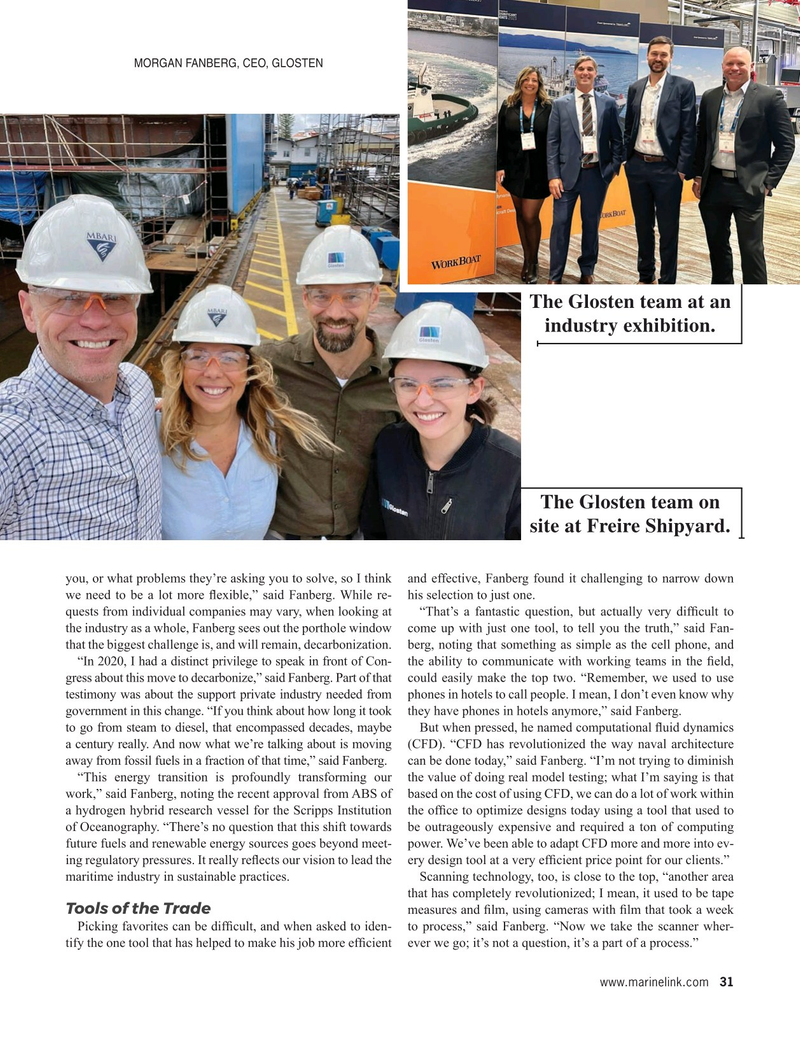
Page 31: of Maritime Reporter Magazine (September 2024)
Read this page in Pdf, Flash or Html5 edition of September 2024 Maritime Reporter Magazine
MORGAN FANBERG, CEO, GLOSTEN
The Glosten team at an industry exhibition.
The Glosten team on site at Freire Shipyard.
you, or what problems they’re asking you to solve, so I think and effective, Fanberg found it challenging to narrow down we need to be a lot more ? exible,” said Fanberg. While re- his selection to just one.
quests from individual companies may vary, when looking at “That’s a fantastic question, but actually very dif? cult to the industry as a whole, Fanberg sees out the porthole window come up with just one tool, to tell you the truth,” said Fan- that the biggest challenge is, and will remain, decarbonization. berg, noting that something as simple as the cell phone, and “In 2020, I had a distinct privilege to speak in front of Con- the ability to communicate with working teams in the ? eld, gress about this move to decarbonize,” said Fanberg. Part of that could easily make the top two. “Remember, we used to use testimony was about the support private industry needed from phones in hotels to call people. I mean, I don’t even know why government in this change. “If you think about how long it took they have phones in hotels anymore,” said Fanberg.
to go from steam to diesel, that encompassed decades, maybe But when pressed, he named computational ? uid dynamics a century really. And now what we’re talking about is moving (CFD). “CFD has revolutionized the way naval architecture away from fossil fuels in a fraction of that time,” said Fanberg. can be done today,” said Fanberg. “I’m not trying to diminish “This energy transition is profoundly transforming our the value of doing real model testing; what I’m saying is that work,” said Fanberg, noting the recent approval from ABS of based on the cost of using CFD, we can do a lot of work within a hydrogen hybrid research vessel for the Scripps Institution the of? ce to optimize designs today using a tool that used to of Oceanography. “There’s no question that this shift towards be outrageously expensive and required a ton of computing future fuels and renewable energy sources goes beyond meet- power. We’ve been able to adapt CFD more and more into ev- ing regulatory pressures. It really re? ects our vision to lead the ery design tool at a very ef? cient price point for our clients.” maritime industry in sustainable practices. Scanning technology, too, is close to the top, “another area that has completely revolutionized; I mean, it used to be tape
Tools of the Trade measures and ? lm, using cameras with ? lm that took a week
Picking favorites can be dif? cult, and when asked to iden- to process,” said Fanberg. “Now we take the scanner wher- tify the one tool that has helped to make his job more ef? cient ever we go; it’s not a question, it’s a part of a process.” www.marinelink.com 31
MR #9 (18-33).indd 31 9/4/2024 1:25:59 PM

 30
30

 32
32
